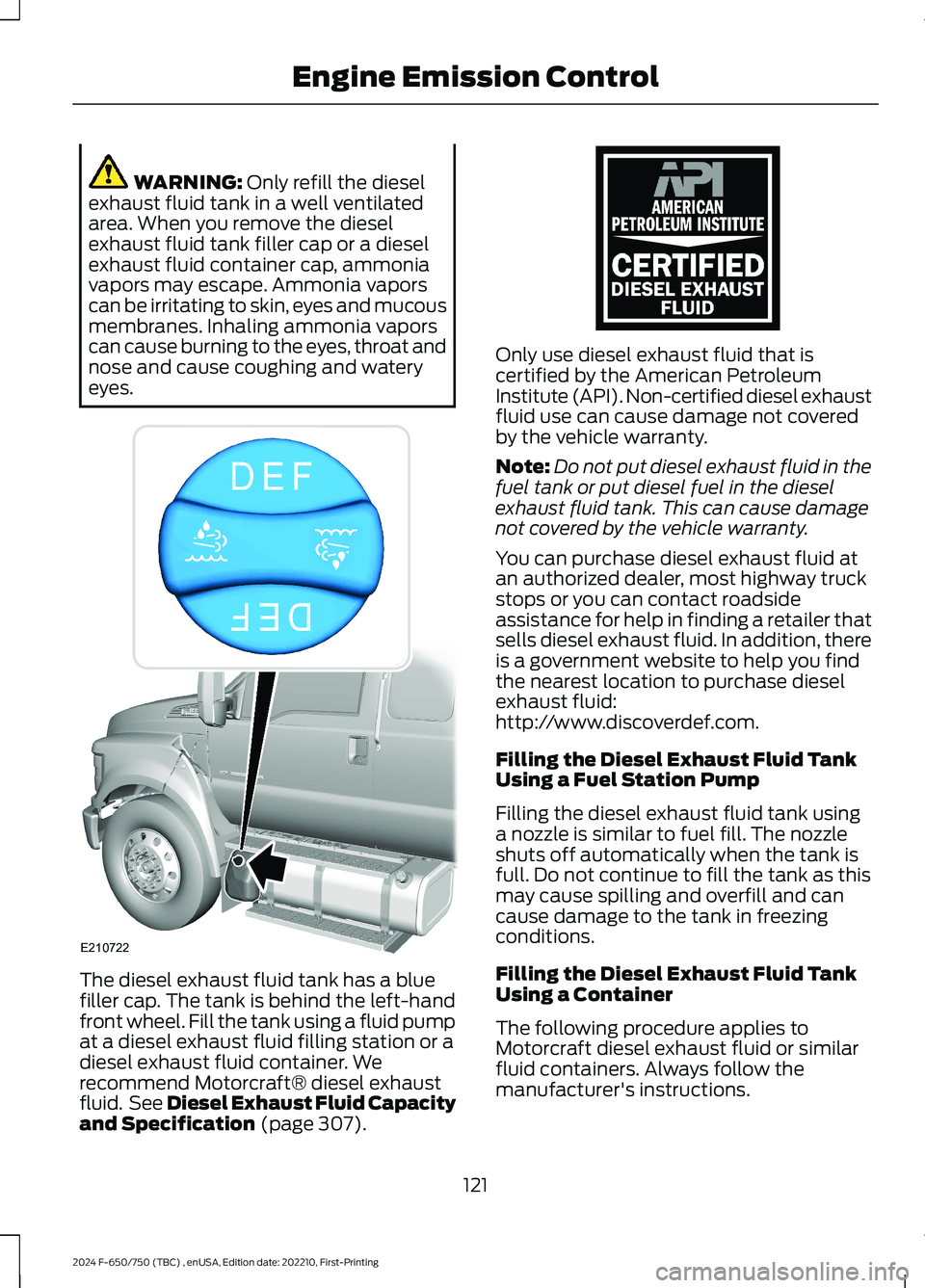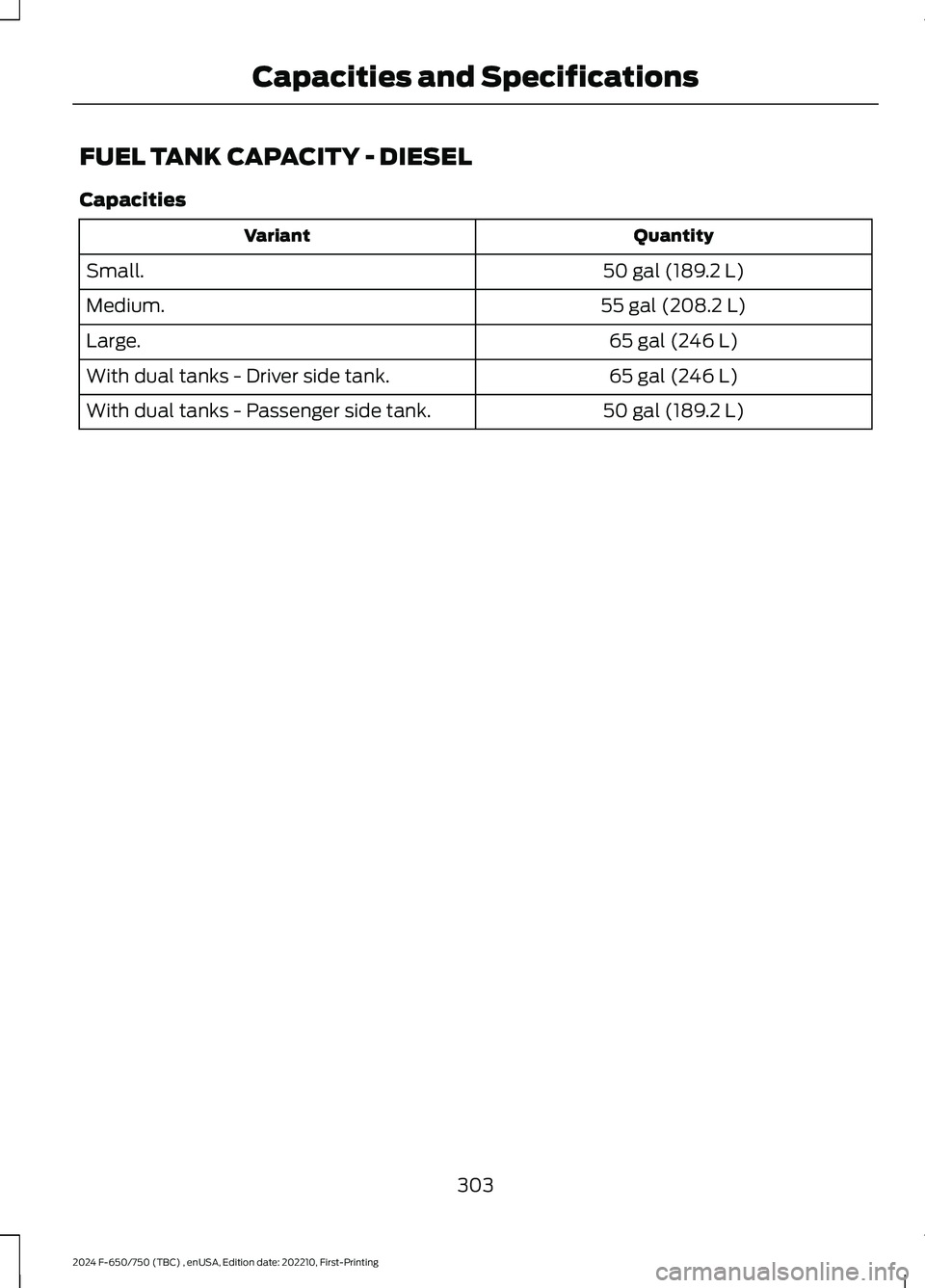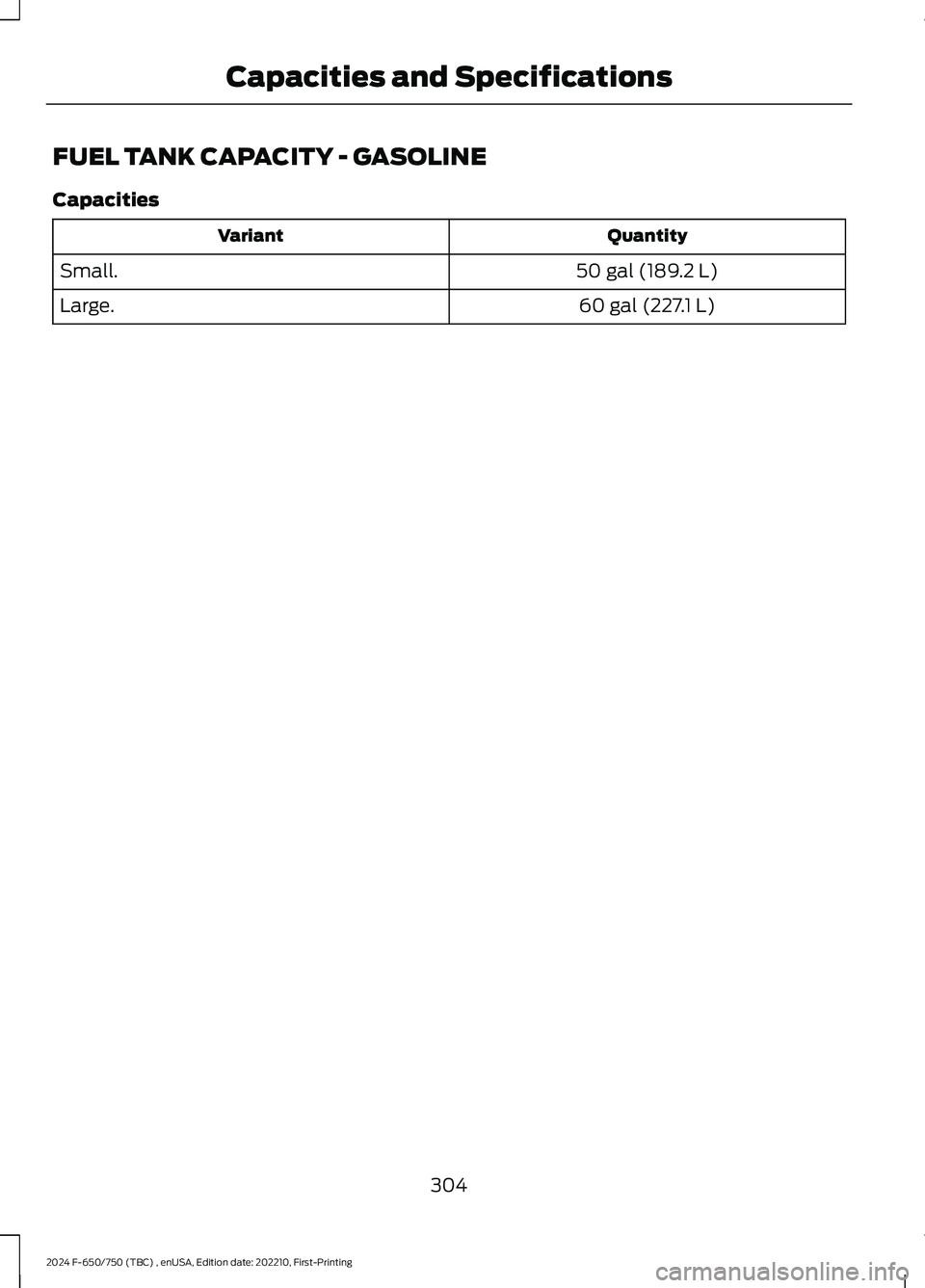2024 FORD F650/750 fuel tank capacity
[x] Cancel search: fuel tank capacityPage 9 of 386

Cleaning the Interior..................................265
Cleaning the Instrument Panel andInstrument Cluster Lens......................266
Repairing Minor Paint Damage.............266
Cleaning the Wheels.................................266
Vehicle Storage............................................267
Wheels and Tires
Tire Care.........................................................269
Using Snow Chains....................................287
Changing a Road Wheel..........................287
Technical Specifications.........................289
Capacities and Specifications
Engine Specifications - 6.7L Diesel.......291
Engine Specifications - 7.3L....................292
Motorcraft Parts - 6.7L Diesel................293
Motorcraft Parts - 7.3L..............................295
Bulb Specification Chart.........................296
Engine Oil Capacity and Specification -6.7L Diesel.................................................296
Engine Oil Capacity and Specification -7.3L...............................................................299
Cooling System Capacity andSpecification - 6.7L Diesel...................301
Cooling System Capacity andSpecification - 7.3L................................302
Fuel Tank Capacity - Diesel....................303
Fuel Tank Capacity - Gasoline..............304
Air Conditioning System Capacity andSpecification - 6.7L Diesel..................305
Air Conditioning System Capacity andSpecification - 7.3L................................306
Washer Fluid Specification....................306
Diesel Exhaust Fluid Capacity andSpecification............................................307
Automatic Transmission Fluid Capacityand Specification - Diesel...................307
Automatic Transmission Fluid Capacityand Specification - Gasoline.............308
Brake Fluid Specification........................309
Rear Axle Fluid Capacity andSpecification - Diesel...........................309
Rear Axle Fluid Capacity andSpecification - Gasoline.........................311
Hydraulic Power Steering Fluid Capacityand Specification.....................................312
Vehicle Identification
Vehicle Identification Number................313
Connected Vehicle
Connected Vehicle Requirements.........314
Connected Vehicle Limitations..............314
Connecting the Vehicle to a MobileNetwork.......................................................314
Connected Vehicle – Troubleshooting.........................................................................314
Audio System
General Information...................................315
Audio Unit.......................................................315
Connecting a Bluetooth® Device..........318
Streaming Bluetooth Audio.....................318
Playing Media From a USB Device........318
Audio Input Jack...........................................319
USB Port........................................................320
Using Voice Recognition..........................320
Accessories
Auxiliary Switches.......................................321
Ford Protect
Ford Protect..................................................323
Scheduled Maintenance
General Maintenance Information.......325
Normal Scheduled Maintenance.........330
Special Operating Conditions ScheduledMaintenance............................................335
5
2024 F-650/750 (TBC) , enUSA, Edition date: 202210, First-PrintingTable of Contents
Page 119 of 386

1.When your vehicle has stopped, shiftinto neutral (N) or park (P).
2.Apply the parking brake and switch theignition off.
3.Turn the fuel filler capcounterclockwise and remove it.
4.Refuel your vehicle as required.
5.Replace the fuel filler cap, turn itclockwise until you feel a strongresistance.
If the fuel cap warning lamp or a warningmessage appears in the instrument cluster,you may not have installed the fuel fillercap correctly.
If the fuel cap warning lamp remains on,at the next opportunity, safely pull off ofthe road, remove the fuel filler cap, alignthe cap properly and reinstall it. The checkfuel cap warning lamp or warning messagemay not reset immediately. It may takeseveral driving cycles for the indicators toturn off. A driving cycle consists of anengine start-up (after four or more hourswith the engine off) followed by normalcity and highway driving.
FUEL CONSUMPTION
The advertised capacity is the maximumamount of fuel that you can add to the fueltank after running out of fuel. Included inthe advertised capacity is an emptyreserve. The empty reserve is anunspecified amount of fuel that remainsin the fuel tank when the fuel gaugeindicates empty.
Note:The amount of fuel in the emptyreserve varies and should not be relied uponto increase driving range.
Filling the Fuel Tank
For consistent results when refueling:
•Turn the ignition off before fueling; aninaccurate reading results if the engineis left running.
•Use the same fill rate(low-medium-high) each time the tankis filled.
•Allow no more than one automaticshut-off when refueling.
Results are most accurate when the fillingmethod is consistent.
Calculating Fuel Economy
Do not measure fuel economy during thefirst 1,000 mi (1,600 km) of driving (this isyour engine’s break-in period). A moreaccurate measurement is obtained after2,000 mi (3,200 km) to 3,000 mi(4,800 km). Also, fuel expense, frequencyof fill ups or fuel gauge readings are notaccurate ways to measure fuel economy.
1.Fill the fuel tank completely and recordthe initial odometer reading.
2.Each time you fill the fuel tank, recordthe amount of fuel added.
3.After at least three fill ups, fill the fueltank and record the current odometerreading.
4.Subtract your initial odometer readingfrom the current odometer reading.
To calculate L/100 km (liters per 100kilometers) fuel consumption, multiply theliters used by 100, then divide by kilometerstraveled. To calculate MPG (miles pergallon) fuel consumption, divide milestraveled by gallons used.
115
2024 F-650/750 (TBC) , enUSA, Edition date: 202210, First-PrintingFuel and Refueling
Page 125 of 386

WARNING: Only refill the dieselexhaust fluid tank in a well ventilatedarea. When you remove the dieselexhaust fluid tank filler cap or a dieselexhaust fluid container cap, ammoniavapors may escape. Ammonia vaporscan be irritating to skin, eyes and mucousmembranes. Inhaling ammonia vaporscan cause burning to the eyes, throat andnose and cause coughing and wateryeyes.
The diesel exhaust fluid tank has a bluefiller cap. The tank is behind the left-handfront wheel. Fill the tank using a fluid pumpat a diesel exhaust fluid filling station or adiesel exhaust fluid container. Werecommend Motorcraft® diesel exhaustfluid. See Diesel Exhaust Fluid Capacityand Specification (page 307).
Only use diesel exhaust fluid that iscertified by the American PetroleumInstitute (API). Non-certified diesel exhaustfluid use can cause damage not coveredby the vehicle warranty.
Note:Do not put diesel exhaust fluid in thefuel tank or put diesel fuel in the dieselexhaust fluid tank. This can cause damagenot covered by the vehicle warranty.
You can purchase diesel exhaust fluid atan authorized dealer, most highway truckstops or you can contact roadsideassistance for help in finding a retailer thatsells diesel exhaust fluid. In addition, thereis a government website to help you findthe nearest location to purchase dieselexhaust fluid:http://www.discoverdef.com.
Filling the Diesel Exhaust Fluid TankUsing a Fuel Station Pump
Filling the diesel exhaust fluid tank usinga nozzle is similar to fuel fill. The nozzleshuts off automatically when the tank isfull. Do not continue to fill the tank as thismay cause spilling and overfill and cancause damage to the tank in freezingconditions.
Filling the Diesel Exhaust Fluid TankUsing a Container
The following procedure applies toMotorcraft diesel exhaust fluid or similarfluid containers. Always follow themanufacturer's instructions.
121
2024 F-650/750 (TBC) , enUSA, Edition date: 202210, First-PrintingEngine Emission ControlE210722 E163354
Page 307 of 386

FUEL TANK CAPACITY - DIESEL
Capacities
QuantityVariant
50 gal (189.2 L)Small.
55 gal (208.2 L)Medium.
65 gal (246 L)Large.
65 gal (246 L)With dual tanks - Driver side tank.
50 gal (189.2 L)With dual tanks - Passenger side tank.
303
2024 F-650/750 (TBC) , enUSA, Edition date: 202210, First-PrintingCapacities and Specifications
Page 308 of 386

FUEL TANK CAPACITY - GASOLINE
Capacities
QuantityVariant
50 gal (189.2 L)Small.
60 gal (227.1 L)Large.
304
2024 F-650/750 (TBC) , enUSA, Edition date: 202210, First-PrintingCapacities and Specifications
Page 383 of 386

Engine Coolant Check - 7.3L....................238Engine Emission Control.............................117Engine Idle Shutdown................................105Engine ImmobilizerSee: Passive Anti-Theft System......................51Engine Oil Capacity and Specification -6.7L Diesel...................................................296Engine Oil Capacity and Specification -7.3L.................................................................299Engine Oil Check...........................................227Engine Oil Dipstick - 6.7L Diesel.............227Engine Oil Dipstick - 7.3L...........................227Engine Specifications - 6.7L Diesel........291Engine Specifications - 7.3L.....................292Entering, Exiting or Climbing on ThisVehicle..............................................................18Environment.....................................................22Essential Towing Checks...........................183Event Data RecordingSee: Data Recording..............................................11Exhaust Brake................................................145Exhaust System Inspection.....................255Export Unique Options.................................18Exterior Mirrors.................................................61
F
Fastening the Seatbelts..............................39Federal Highway AdministrationRegulation.......................................................18Fifth Wheel Operation................................184Flat TireSee: Changing a Road Wheel........................287Ford Credit.........................................................15Ford Protect...................................................323Frame and Tow Hook Inspection..........260Front Seat Armrest........................................95Fuel and Refueling.......................................107Fuel Consumption.........................................115Fuel Filter - 7.3L............................................249Fuel Quality - Diesel....................................108Fuel Quality - Gasoline.................................111Fuel Tank Capacity - Diesel.....................303Fuel Tank Capacity - Gasoline...............304Fuel Tank Selector Switch.........................116Fuses................................................................202Fuse Specification Chart..........................202
G
Gauges...............................................................64GearboxSee: Transmission..............................................130General Driving Points................................186General Information on RadioFrequencies...................................................46General Maintenance Information........325Getting Assistance Outside the U.S. andCanada..........................................................199Getting the Services You Need...............196
H
HandbrakeSee: Parking Brake.............................................140Hazard Flashers............................................190Headlamp AdjustingSee: Adjusting the Headlamps.....................248Headlamp Exit Delay....................................56Headlamp RemovalSee: Removing a Headlamp..........................250HeadrestSee: Head Restraints..........................................89Head Restraints..............................................89Heated Exterior Mirrors................................88HeatingSee: Climate Control..........................................86Hill Start Assist - Vehicles With:Hydraulic Brakes........................................143Hints on Controlling the InteriorClimate............................................................87Hints on Driving With Anti-LockBrakes............................................................140Hood LockSee: Opening and Closing the Hood...........223Horn.....................................................................53How Does the Pneumatic LockingDifferential Work........................................137Hydraulic Power Steering Fluid Capacityand Specification.......................................312
I
Ignition Switch................................................101In California (U.S. Only)..............................197Information Display Control.......................53
379
2024 F-650/750 (TBC) , enUSA, Edition date: 202210, First-PrintingIndex